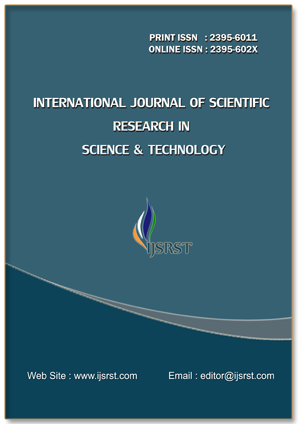High Throughput DWT Architecture for Signal Processing
DOI:
https://doi.org/10.32628/IJSRST24114109Keywords:
High Throughput, Discrete Wavelet Transform, Signal Processing, Parallel Processing, Optimization, Architecture DesignAbstract
The Discrete Wavelet Transform (DWT) is essential in signal processing systems because it is capable of accurately recording both frequency and time-domain features. Nevertheless, the computational intricacy of DWT presents notable obstacles to processing in real-time, particularly in circumstances with large data consumption. This study presents a VLSI technology designed to accelerate DWT processing utilizing CMOS gates. The goal is to improve throughput while maintaining area efficiency. The architecture utilizes parallelism and pipelining techniques to take use of the fundamental redundancy in DWT processing. We focus on creating customized processing units developed specifically for performing Discrete Wavelet Transform (DWT) operations. These units are tuned to make the best possible usage of CMOS gate capabilities. The proposed architectural is implemented using Cadence virtuoso software with 45 nm design. It is evaluated based on its area, power consumption, and latency. The current techniques employed to assess the proposed design include the utilization of the Radix-2 technique for FIR filter design, as well as the employment of look-up-table carry select adder (LCSLA), Vedic design (VD), and carry look-ahead adder (CLA). The developed system design has an area of 1764 um2, which makes it smaller than that of conventional approaches.
Downloads
References
Bu Q, Luo J, Ma K, Feng H, Feng J. An Enhanced pix2pix Dehazing Network with Guided Filter Layer. Applied Sciences. 2020; 10(17):5898. https://doi.org/10.3390/app10175898 DOI: https://doi.org/10.3390/app10175898
L. Jiao, C. Hu, L. Huo and P. Tang, "Guided-Pix2Pix: End-to-End Inference and Refinement Network for Image Dehazing," in IEEE Journal of Selected Topics in Applied Earth Observations and Remote Sensing, vol. 14, pp. 3052-3069, 2021, doi: 10.1109/JSTARS.2021.3061460. DOI: https://doi.org/10.1109/JSTARS.2021.3061460
Naqvi RA, Arsalan M, Rehman A, Rehman AU, Loh W-K, Paul A. Deep Learning-Based Drivers Emotion Classification System in Time Series Data for Remote Applications. Remote Sensing. 2020; 12(3):587. https://doi.org/10.3390/rs12030587 DOI: https://doi.org/10.3390/rs12030587
Omarov, B., Narynov, S., Zhumanov, Z., Gumar, A., & Khassanova, M. (2022). State-of-the-art violence detection techniques in video surveillance security systems: a systematic review. PeerJ Computer Science, 8, e920. DOI: https://doi.org/10.7717/peerj-cs.920
Z. Li, Z. -S. Kuang, Z. -L. Zhu, H. -P. Wang and X. -L. Shao, "Wavelet-Based Texture Reformation Network for Image Super-Resolution," in IEEE Transactions on Image Processing, vol. 31, pp. 2647-2660, 2022, doi: 10.1109/TIP.2022.3160072. DOI: https://doi.org/10.1109/TIP.2022.3160072
F. A. Dharejo et al., "Multimodal-Boost: Multimodal Medical Image Super-Resolution Using Multi-Attention Network With Wavelet Transform," in IEEE/ACM Transactions on Computational Biology and Bioinformatics, vol. 20, no. 4, pp. 2420-2433, 1 July-Aug. 2023, doi: 10.1109/TCBB.2022.3191387. DOI: https://doi.org/10.1109/TCBB.2022.3191387
Ran, J., Zhang, Z. (2022). Lightweight Wavelet-Based Transformer for Image Super-Resolution. In: Khanna, S., Cao, J., Bai, Q., Xu, G. (eds) PRICAI 2022: Trends in Artificial Intelligence. PRICAI 2022. Lecture Notes in Computer Science, vol 13631. Springer, Cham. https://doi.org/10.1007/978-3-031-20868-3_27 DOI: https://doi.org/10.1007/978-3-031-20868-3_27
S. A. Hovhannisyan, H. A. Gasparyan, S. S. Agaian and A. Ghazaryan, "AED-Net: A Single Image Dehazing," in IEEE Access, vol. 10, pp. 12465-12474, 2022, doi: 10.1109/ACCESS.2022.3144402. DOI: https://doi.org/10.1109/ACCESS.2022.3144402
Othman, M. K., & Abdulla, A. A. (2022). Enhanced Single Image Dehazing Technique based on HSV Color Space. UHD Journal of Science and Technology, 6(2), 135–146. https://doi.org/10.21928/uhdjst.v6n2y2022.pp135-146 DOI: https://doi.org/10.21928/uhdjst.v6n2y2022.pp135-146
Po-Wen Hsieh, Pei-Chiang Shao, Variational contrast-saturation enhancement model for effective single image dehazing, Signal Processing, Volume 192,2022, 108396, ISSN 0165-1684,https://doi.org/10.1016/j.sigpro.2021.108396. DOI: https://doi.org/10.1016/j.sigpro.2021.108396
Yu, T., Zhu, M. & Chen, H. Single image dehazing based on multi-scale segmentation and deep learning. Machine Vision and Applications 33, 33 (2022). https://doi.org/10.1007/s00138-022-01285-y DOI: https://doi.org/10.1007/s00138-022-01285-y
Soonyoung Hong, Moon Gi Kang, Single image dehazing based on pixel-wise transmission estimation with estimated radiance patches, Neurocomputing, Volume 492, 2022, Pages 545-560, ISSN 0925-2312,https://doi.org/10.1016/j.neucom.2021.12.046. DOI: https://doi.org/10.1016/j.neucom.2021.12.046
Hassan, H., Mishra, P., Ahmad, M. et al. Effects of haze and dehazing on deep learning-based vision models. Appl Intell 52, 16334–16352 (2022). https://doi.org/10.1007/s10489-022-03245-5 DOI: https://doi.org/10.1007/s10489-022-03245-5
Radhakrishnan, P., & Themozhi, G. (2020). FPGA implementation of XOR-MUX full adder based DWT for signal processing applications. Microprocessors and Microsystems, 73, 102961. DOI: https://doi.org/10.1016/j.micpro.2019.102961
Chandra, M., Goel, P., Anand, A., & Kar, A. (2021). Design and analysis of improved high-speed adaptive filter architectures for ECG signal denoising. Biomedical Signal Processing and Control, 63, 102221. DOI: https://doi.org/10.1016/j.bspc.2020.102221
Seidel, H. B., da Rosa, M. M. A., Paim, G., da Costa, E. A. C., Almeida, S. J., & Bampi, S. (2021). Approximate pruned and truncated Haar discrete wavelet transform VLSI hardware for energy-efficient ECG signal processing. IEEE Transactions on Circuits and Systems I: Regular Papers, 68(5), 1814-1826. DOI: https://doi.org/10.1109/TCSI.2021.3057584
Sadaghiani, A. K., Sheilkhai, S., & Forouzandeh, B. (2020, August). High performance image compression based on optimized EZW using hidden Markov chain and gaussian mixture model. In 2020 28th Iranian Conference on Electrical Engineering (ICEE) (pp. 1-5). IEEE. DOI: https://doi.org/10.1109/ICEE50131.2020.9260835
Tyagi, A., & Mehra, R. (2021). Intellectual heartbeats classification model for diagnosis of heart disease from ECG signal using hybrid convolutional neural network with GOA. SN Applied Sciences, 3, 1-14. DOI: https://doi.org/10.1007/s42452-021-04185-4
Wen, H., Chen, Z., Zheng, J., Huang, Y., Li, S., Ma, L., ... & Yang, H. (2022). Design and embedded implementation of secure image encryption scheme using DWT and 2D-LASM. Entropy, 24(10), 1332. DOI: https://doi.org/10.3390/e24101332
Osadchiy, A., Kamenev, A., Saharov, V., & Chernyi, S. (2021). Signal processing algorithm based on discrete wavelet transform. Designs, 5(3), 41. DOI: https://doi.org/10.3390/designs5030041
Holla, M.R., Pais, A.R. High-performance medical image secret sharing using super-resolution for CAD systems. Appl Intell 52, 16852–16868 (2022). https://doi.org/10.1007/s10489-021-03095-7 DOI: https://doi.org/10.1007/s10489-021-03095-7
Downloads
Published
Issue
Section
License
Copyright (c) 2024 International Journal of Scientific Research in Science and Technology

This work is licensed under a Creative Commons Attribution 4.0 International License.
https://creativecommons.org/licenses/by/4.0





